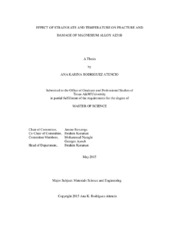| dc.description.abstract | Due to their low density and high specific strength, magnesium and its alloys are structural metals attractive for the aerospace and automotive industries. However, wide spread use of wrought magnesium is challenged by its limited formability at low temperature compared to aluminum and steel. This results in costly production and processing of sheet and plate material. Extensive research has been carried out on deformation mechanisms, mechanical characterization, new processing routes and alloying systems in order to overcome these limitations. However, the available literature on damage and fracture is limited. In particular, the effects of temperature and strain rate on damage and fracture remain unexplored. The purpose of this study is to investigate this effects on damage accumulation to fracture in a magnesium alloy. Twin roll cast magnesium plates of AZ31B were used to that end. An extensive experimental campaign of tensile tests at various strain rates and temperatures was performed with this aim. In addition, a series of interrupted tests were carried out to investigate the microscopic damage mechanisms by means of optical and scanning electron microscopy.
The materials were found to have a positive strain rate sensitivity and showed thermal softening. Microstructural studies revealed an increased propensity to form deformation twinning at higher strain rates and lower temperatures, as expected. The fracture behavior was characterized in terms of the work to fracture (Wf). Wf exhibited a maximum at some strain rate dependent on temperature. Conversely, at a fixed strain rate, Wf showed a maximum at a temperature dependent on strain rate. To understand these trends, microscopy analysis was carried out on selected conditions. Under all the conditions examined, two main damage sites were identified: second phase particles and twinning. However, the propensity for twin-sized cracks was highest under conditions where the density of twinning was lowest. Different scenarios are explored in order to rationalize this behavior. | en |


